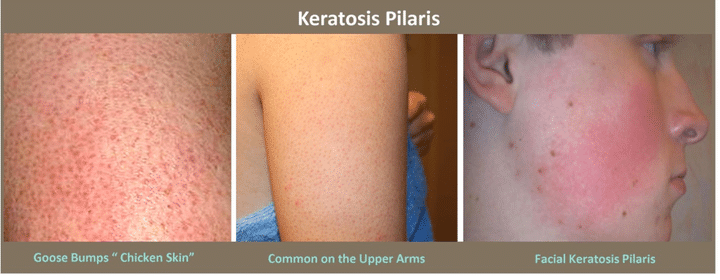Keratosis Pilaris - Know More About It!
Keratosis Pilaris
Keratosis pilaris is a common problem that does not harm your skin. In keratosis pilaris, you get rough, dry patches and small bumps generally on your upper arms, buttocks, thighs, or sometimes cheeks. Sometimes, these bumps can get brown or red in color. In most of the cases, bumps do not itch or hurt. Due to keratosis pilaris, you may have the appearance of chicken skin, goosebumps, or gooseflesh. It can affect any person of any age. This problem is generally noticed in people with atopic dermatitis and dry skin conditions. It is not possible to cure and prevent this skin problem. You can treat this with the help of moisturizers and creams prescribed by your doctor to improve the appearance of your skin. Keratosis pilaris does not harm you in any way or does not worsen your situation, except it can cause you itching. This problem usually increases as you grow older. Many teenagers and children get this problem and it disappears as they grow old. It is not a contagious problem. Keratosis pilaris can get worse if it occurs during winter months or pregnancy.
Keratosis Pilaris Symptoms
Check out the various possible symptoms or signs of keratosis pilaris:
- You may get small painless bumps generally on your upper arms, cheeks, buttocks, or thighs.
- You may notice rough, dry skin at the place of the bumps.
- Symptoms may get worse when seasonal changes lead to low humidity, your skin may get drier.
- Sandpaper-like bumps look similar to gooseflesh.
- Bumps can be of different colors depending on the tone of the skin. They can be white, pink, red, brown, black, or flesh-colored.
- You may have irritable or itchy skin due to keratosis pilaris.
- You may notice slight redness or pinkness around the area of bumps.
Keratosis Pilaris Causes
Keratosis pilaris occurs when keratin builds up. The keratin is a fibrous protein that helps your skin to get protection from infection and harmful substances. The keratin forms a hard, scaly plug due to which there is a blockage in the opening of the hair follicle. Generally, a lot of plugs form, leading to bumpy, rough skin patches. It is not known or clear why keratin builds up. Keratosis pilaris may happen in association with some skin conditions including atopic dermatitis or genetic diseases. This condition may get worse if a person has dry skin.
How is it diagnosed?
Keratosis pilaris is a condition which does not require treatment as it resolves on its own. Your doctor can easily recognize that you have keratosis pilaris by just knowing and looking at your symptoms. Your doctor may ask you if you have a family history of keratosis pilaris as this problem is associated with a genetic component. Your doctor will conduct a physical examination in order to confirm the diagnosis. Since this problem can easily be recognized by an appearance of the affected skin so no laboratory test is required for diagnosing keratosis pilaris. Your doctor may ask you to get a skin biopsy done if your case is extreme or unusual.
Prevention
It is not possible to prevent keratosis pilaris. You can keep your skin moist to reduce the risk of developing keratosis pilaris. Check out the various ways that will help you to keep your skin in a comfortable state:
- You should not be in the water for a longer period.
- You should use that soap which has added fat or oil.
- You should rub your skin gently to avoid the scratching of bumps.
- You should use warm water for showering and bathing instead of hot water.
- You should use those moisturizers on your skin which are thick.
- You should use a humidifier in your home to add moisture to the air.
Keratosis Pilaris Treatment
It is not possible to cure keratosis pilaris. You can apply moisturizing creams or lotions as it will make your skin feel and look better. You can get a lot of creams and lotions over the counter but if you need stronger versions then you need a prescription from your doctor. There are two types of products that are generally used to improve the condition of keratosis pilaris. These products are directly applied on the affected skin. If you really want to see the improvement then you will have to use these products regularly for many weeks. Check out various treatment options available for keratosis pilaris:
- Topical exfoliants: Topical exfoliants are used to eliminate the dead cells from the surface of the skin. These creams have lactic acid, urea, alpha-hydroxy acid, or salicylic acid. The acids which are available in the creams may cause a feeling of slight burning or redness. That is why young children should not use these creams.
- Topical retinoids: Topical retinoids include gels, lotions, and creams which are derived from Vitamin A. These are used to prevent hair follicles from getting plugged. The ingredients which are used in these products are tazarotene (Tazorac and Avage) and tretinoin (Retin-A, Renova, and Avita). But the products of topical retinoids can cause peeling, redness, and irritation in your skin. Those women who are nursing, pregnant or planning to conceive should avoid using topical retinoids.
- Laser treatment: This treatment method is used when a person experiences severe inflammation and redness. It is not a cure for keratosis pilaris. But it can be used when lotions and creams do not work properly. In this, a laser is done onto the skin. To get the proper result a person has to undergo various sessions.
Complications
It is a cosmetic skin condition so complications are not frequent. Check out various complications associated with keratosis pilaris:
- Permanent scarring: Permanent scarring is a major complication of keratosis pilaris. Though, it happens rarely. It can happen due to inflammation and aggressive treatment methods used.
- Temporary skin discoloration: Temporary skin discoloration is also known as post-inflammatory hypopigmentation. You may notice the temporary skin color changes after the improvement of red, inflamed bumps or after a temporary flare.
- Hyperpigmentation: Sometimes, keratosis pilaris can lead to hyperpigmentation. It can also happen due to after a temporary flare or after the improvement of red, inflamed bumps.
Myths
Check out various myths associated with keratosis pilaris:
Myth #1: Applying any lotion can help to reduce the bumps.
Fact: Keratosis pilaris bumps can become worse due to dry skin. Only applying lotion would not help to eliminate the symptoms of keratosis pilaris completely. The bumps can exfoliate by gently using a lotion with chemical exfoliants.
Myth #2: You can treat them with acne medication as they are just pimples.
Fact: Many people misunderstand keratosis pilaris as eczema, psoriasis, or acne. But keratosis pilaris is different from pimples. It is a completely different condition. The treatment method for keratosis pilaris is different from other skin problems. Acne medicines are given to dry pimples. Taking the medicine of acne in keratosis pilaris can make your symptoms even worse.
Myth #3: No treatment options are available for keratosis pilaris.
Fact: It is true that there is no cure for keratosis pilaris but still you can reduce your symptoms or improve the physical appearance of those small bumps. You can see improvement in around 3 weeks after using an exfoliating skin cream or a body scrub while taking shower two times regularly. The best way to manage your keratosis pilaris is using a treatment regimen for keratosis pilaris such as keratosis pilaris elements.
Myth #4: Eating a gluten-free diet can help to cure keratosis pilaris.
Fact: Many people believe that they can cure their keratosis pilaris by removing gluten from your diet. A gluten-free diet will have a very less impact on the keratin production in the hair follicles. Keratosis pilaris occurs due to the overproduction of keratin and not because of the diet.
Myth #5: The problem of keratosis pilaris can be transmitted.
It is a misconception as keratosis pilaris is not a contagious condition. You can get keratosis pilaris by following unsafe sex practices, from someone's cough or sneeze, or by sitting on toilet seats. This problem does not transmit to another person due to a close contact. This problem is closely associated with a genetic component. You may inherit this problem from your grandparents or parents due to heredity. You can have this problem even if your parents or grandparents do not have it.
Conclusion
Keratosis pilaris is a common skin problem that is not contagious means it can not be transmitted through a direct contact. This problem does not harm your skin. A person with keratosis pilaris may notice rough, dry patches and small bumps on the upper arms, buttocks, thighs, or sometimes cheeks. It can occur to any person of any age. Irritable or itchy skin, small painless bumps, rough, dry skin, and slight redness or pinkness around the area of bumps are some of the possible symptoms of keratosis pilaris. If it occurs during the winter season or pregnancy then your symptoms may become worse. You cannot cure and prevent this skin problem.
Due to the buildup of keratin, keratosis pilaris can occur. Though, no one knows why keratin builds up. It may occur in association with some skin conditions including atopic dermatitis or genetic diseases. Generally, people with keratosis pilaris do not need to visit a doctor as this problem goes on its own. It goes away as a person grows older. You must visit a doctor if you experience severe symptoms. Your doctor will conduct a physical examination and will ask you about your symptoms. Your doctor can easily recognize keratosis pilaris by just having a look at the appearance of your affected skin. No diagnostic test is required. In certain cases, your doctor may ask you to get a biopsy done.
You should follow some tips that help you to keep your skin in a comfortable state. You should use a soap which has added fat or oil. You should use warm water for bathing and showering rather than hot water. You should use thick moisturizers on your skin. Topical exfoliants, topical retinoids, and laser treatment are some of the treatment options available for treating patients with keratosis pilaris. Topical exfoliants should be used by children as they may cause redness or a feeling of slight burning. Women who are nursing, pregnant or planning to conceive should avoid using topical retinoids as they may have some side effects. Laser treatment cannot cure your skin problem.
There are some infrequent complications that are associated with keratosis pilaris. Permanent scarring, hyperpigmentation, and temporary skin discoloration or post-inflammatory hypopigmentation are some of the major complications associated with keratosis pilaris. People have many myths or misconceptions about keratosis pilaris. You can treat bumps with acne medication as they are just pimples is one of the common myths. The problem of keratosis pilaris can be transmitted is another common myth.



+1.svg)
